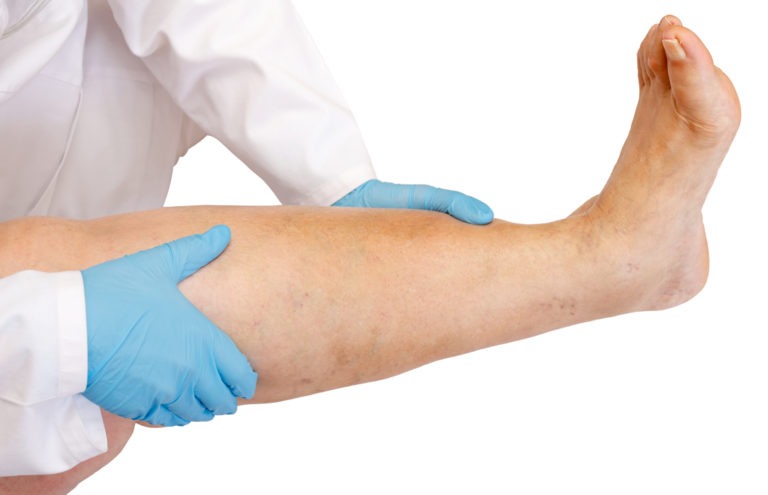[vc_row][vc_column][vc_column_text]DVT, otherwise known as deep vein thrombosis, is no laughing matter. It’s the result of blood clots that are hidden deep inside of you. DVT strikes most often in the lower legs or the thighs. If left untreated, it can put you at severe risk of developing a pulmonary embolism. A pulmonary embolism is a blockage of a blood vessel located in your lungs. When a clot blocks the vessels in your lungs, it could cause irreparable damage to your lungs or other vital organs.
Leg Swelling and Pain are Symptoms of DVT
DVT may cause no symptoms, or you may experience some of the classic signs of this dangerous condition. The symptoms include recurrent pain in the leg, swelling and redness. This may be caused by a clot that limits blood flow and allows for fluid to collect in the lower leg. This can make the leg swollen, painful and prone to leg ulcers. Other symptoms are leg heaviness, itchiness, tingling, cramping and sores on the leg.
Symptoms List
- If you experience swelling in one leg or a severe pain suddenly strikes in your calf, you may be suffering from DVT.
- Extreme pain that affects your ankle and your foot could indicate a problem as well.
- A feeling of unexplained heat in the affected part of your body.
- Change in skin color such as inflammation or a blue tint.
What do you if you have a Symptom of DVT
If you are experiencing any of the symptoms described in this article, the Miami Vein Center is the ideal place for you to seek treatment for Deep Vein Thrombosis in Miami. Thanks to Dr. Almeida’s world-renowned expertise and our highly qualified team, patients gain a thorough understanding of how their medical history and lifestyle affect their risk of developing thrombosis. Treatment plans are tailored to meet each patient’s needs and symptoms.
About Deep Vein Thrombosis with Dr. Almeida
[/vc_column_text][vc_video link=”https://youtu.be/AN_cCyB6r40″ align=”center”][vc_column_text]
About Deep Vein Thrombosis
As its name suggests, Deep Vein Thrombosis is a condition whereby a clot (or thrombus) forms in in the deep vein system. Deep veins, such as the femoral vein, are vastly important for moving the blood toward the heart. They carry 90% or more of the blood from the legs into the heart. When a person suffers injury to these veins, he or she is also likely to experience a slowing of blood flow which creates a propensity for the blood to clot. Left untreated, this condition can become lethal.
Causes of Deep Vein Thrombosis
The aforementioned factors—damage to the veins, slowed blood flow and blood coagulation–are three of the most common causes of thrombosis. While thrombosis is inherently dangerous, the health risk is enhanced when blood clots travel to vital organs like the lungs. For example, a pulmonary embolism is the result of a clot migrating to a lung artery. This blockage to the artery in turn compromises the ability of the heart to pump oxygenated blood to the body. The heart thus experiences added strain and blood does not travel to the organs as easily.
DVT Treatment with Dr. Almeida
Is this video board certified vascular surgeon Dr. Jose Almeida describes the treatment options for deep vein thrombosis.[/vc_column_text][vc_video link=”https://youtu.be/Za2WfIN3N6k” align=”center”][vc_column_text]
More about DVT Treatment
Deep Vein Thrombosis is usually treated with anticoagulant drugs, clot busting medicine (thrombolytic agents,) and or surgical procedures.
Anticoagulant drugs thin the blood
Anticoagulant drugs thin the blood, preventing new clots from forming and existing clots from enlarging. Clot busting medicine is used in the event clots are very large and cause pain, and when the person is at high risk of pulmonary embolism. The medicine breaks up the clot to enhance blood flow.
Surgery to support blood
Surgery may be necessary to support blood flow when the first two methods are ineffective. A catheter, for example, can be introduced into the Iliac vein to support blood circulation by enlarging the blood vessel.
Can DVT Lead to Leg Pain and Swelling After Treatment?
If you are diagnosed with deep vein thrombosis, it’s important that you receive treatment. Once you have been treated for DVT, you will be given instructions to care for your condition, including changes in lifestyle and medication. If you experience pain and swelling after your treatment, you are sure to have concerns.
Residual Symptoms after DVT Treatment?
 If you’ve been a victim of DVT, you have to always be on your guard. Once you have had treatment, you expect that you will no longer suffer from the swelling and pain that sent you to our office in the first place. However, you may experience long-term damage after treatment, especially if your condition was severe.
If you’ve been a victim of DVT, you have to always be on your guard. Once you have had treatment, you expect that you will no longer suffer from the swelling and pain that sent you to our office in the first place. However, you may experience long-term damage after treatment, especially if your condition was severe.
- Chronic problems may continue to affect you, such as cramping, an ache that doesn’t go away and more swelling.
- Your affected limb, whether it’s your arm or your leg, may feel heavy all of the time.
If you suffer pain and swelling after you have already dealt with DVT, it can be frustrating and alarming.
What Can You Do to Find Relief from Symptoms After Treatment?
You may notice that your discomfort is at its worst toward the end of the day. When it comes to pain in your legs, you are likely to find that you suffer more when you stay on your feet.
- Resting as much as possible and raising an affected limb can be helpful.
- Compression garments can be helpful in reducing swelling, as well as the pain.
- If you need to take medication for the pain, you should take acetaminophen.
- IMPORTANT: Ibuprofen puts you at risk of uncontrolled bleeding, especially if you are taking medication prescribed to combat deep vein thrombosis.
Post Thrombotic Syndrome Following DVT
While the health risks are greatly reduced with DVT treatments, some patients still experience discomfort, along with the signs and symptoms of chronic venous insufficiency, known as Post-thrombotic syndrome. Post-thrombotic syndrome is a condition that develops in almost half of all who experience Deep Vein Thrombosis.
When Should You Be Concerned about DVT?
If your symptoms are severe, you cannot find relief or you experience symptoms of a pulmonary embolism, you should seek medical attention. Symptoms may include difficulty breathing with pain in your chest. Your heart rate may increase or you could become dizzy.
Book a Leg Pain and Leg Swelling Consultation at Miami Vein Center
If you have any doubts, it’s always best to seek help from the healthcare professionals at Miami Vein Center. Talk to our board certified vascular surgeon, Dr. Jose Almeida to manage your discomfort after DVT treatment and help find a solution that works for you.
Important note on DVT Treatment
It is imperative that anyone who has been diagnosed with Deep Vein Thrombosis follow the doctor’s prescribed regimen closely. Such patients will likely need to follow-up with their physician regularly to monitor their blood circulation and assess the effectiveness of the treatment. Seeking advice from a venous expert is also highly recommended, as the side effects of Deep Vein Thrombosis might be severe.[/vc_column_text][/vc_column][/vc_row]

